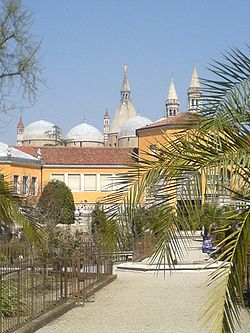Orto Botanico di Padova
| Botanical Garden (Orto Botanico), Padua | |
|---|---|
| Name as inscribed on the World Heritage List | |
 |
|
| Location | Italy |
| Type | Cultural |
| Criteria | ii, iii |
| Reference | 824 |
| UNESCO region | Europe and North America |
| Inscription history | |
| Inscription | 1997 (21st Session) |
The Orto Botanico di Padova is a botanical garden in Padua, in the northeastern part of Italy. Founded in 1545 by the Venetian Republic, it is the world's oldest academic botanical garden that is still in its original location. The garden, affiliated with the University of Padua, currently covers roughly 22,000 square meters, and is known for its special collections and historical design.
The Garden of Padua was founded upon deliberation of the Senate of the Venetian Republic. It was devoted to the growth of medicinal plants, the so-called "simple plants" (Orto dei semplici) which produced natural remedies, and also to help students distinguish genuine medicinal plants from false ones.
A circular wall enclosure was built to protect the garden from the frequent night thefts which occurred in spite of severe penalties (fines, prison, exile). The Botanical Garden was steadily enriched with plants from all over the world, particularly from the countries that participated in trade with Venice. Consequently, Padua had a leading role in the introduction and study of many exotic plants, and a herbarium, a library and many laboratories were gradually added to its Botanical Garden.
At present, the Botanical Garden allows for intensive didactic activity as well as important research to be conducted on its grounds. It also cares for the preservation of many rare species. In 1997, it was listed by UNESCO as a World Heritage Site on the following grounds:
The Botanical Garden of Padua is the original of all botanical gardens throughout the world, and represents the birth of science, of scientific exchanges, and understanding of the relationship between nature and culture. It has made a profound contribution to the development of many modern scientific disciplines, notably botany, medicine, chemistry, ecology and pharmacy.
The design of the Botanical Garden is commonly attributed to Andrea Moroni, who created some of the most important public monuments in Padua, such as the Basilica of Santa Giustina in Prato della Valle, the town hall and the university in the first half of the 16th century. However, the real architect was Daniele Barbaro, a Venetian nobleman who was a man of vast learning and translator of Vitruvius' De Architectura. He followed the example of the medieval Horti Conclusi, (enclosed gardens), marking the architecture by a perfect pattern of a square within a circle, divided into four parts by two paths oriented according to the cardinal points. The Botanical Garden was inaugurated in 1545, and used as a teaching facility by the University of Padua in the following year.
...
Wikipedia
